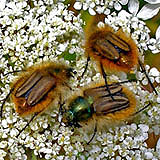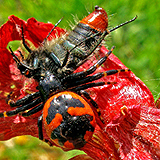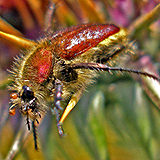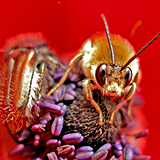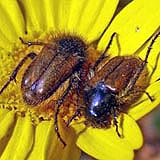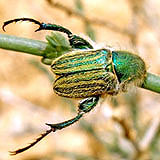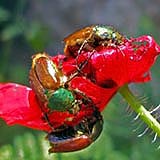The GLAPHYRIDAE Family
Overview
 Glaphyrid beetles are active fliers during the day. Adults of many species are brightly colored and hairy and often possess markings and coloration resembling bees and bumblebees. They are strong fliers and are often observed hovering near flowers or foliage or flying over sandy areas.
Glaphyrid beetles are active fliers during the day. Adults of many species are brightly colored and hairy and often possess markings and coloration resembling bees and bumblebees. They are strong fliers and are often observed hovering near flowers or foliage or flying over sandy areas.
The text below is a compilation of several documents mainly by
David C. Carlson
and by Shauna Joy Hawkins.
Description
Length 6-20 mm. Shape elongate. Color testaceous to black, often with metallic reflections; setae dense, moderately long, color variable (white, yellow, orange, red, brown, or black). Head deflexed. Antennae 9 or 10-segmented with 3-segmented, opposable club (all segments tomentose). Eyes with eucone ommatidia, completely or partially divided by a canthus. Clypeus usually simple, anterior margin with or without teeth. Labrum emarginate, truncate or rounded, produced beyond apex of clypeus, prominent. Mandibles produced beyond apex of labrum, prominent. Maxillae filiform, plumose or truncate, with 4 or 5-segmented palpi. Labium with 4-segmented palpi. Pronotum convex, usually subquadrate, often densely punctate and setose, without tubercles, ridges, horns, or sulci. Elytra elongate, often thin and dehiscent at apex, without striae, often setose. Pygidium usually visible beyond elytra. Scutellum exposed, U-shaped or triangular. Legs with procoxae conical or transverse, meso- and metacoxae transverse; mesocoxae separated or contiguous; protibiae dentate on outer margin, apex with one spur; meso- and metatibia generally simple but some with apical modifications (spines or emarginations), apex with 2 spurs; tarsi 5-5-5, foretarsi modified medially (pectinate) in some Palaearctic genera; claws equal in size with 1 tooth; empodium exposed beyond fifth tarsal segment, dorso-ventrally flattened, with 2 setae. Abdomen with 6 free sternites, usually with 8 pairs of spiracles; spiracles 1-6 or 1-7 situated in pleural membrane, spiracles 7 or 8 in tergites. Wings well developed, M-Cu loop present with 1 apical, detached vein. Male genitalia with well sclerotized, strongly arched basal piece, basal piece large relative to parmeres; internal sac variable. Ovary with 6 ovarioles. (Carlson 1980; Chapin 1938; d'Hotman and Scholtz 1990; Ritcher 1969; Ritcher and Baker 1974; Scholtz 1990). The larvae are scarabaeiform (C-shaped, cylindrical). Color bluish-white to yellow (prepupae) (except at caudal end which maybe darkened by accumulated feces). Head capsule heavily sclerotized, reddish-brown (Lichnanthe with conspicuous median, circular depression on frons). Antennae 4-segmented, third segment with small sensory pits. Ocelli present or absent. Frontoclypeal suture present. Labrum trilobed. Epipharynx with asymmetrical tormae not fused. Maxilla with galea and lacinia separate; maxillary palpi 4-segmented; labial palpi 2-segmented; maxillary and mandibular stridulatory areas present. Abdominal segments 1 to 8 with 3 dorsal annuli. Spiracles cribriform. Anal slit transverse, located caudally on dorsum of last abdominal segment. Legs well developed, 4-segmented, lacking stridulatory organs; claws present. (Ritcher 1966; Scholtz 1990).
Ecology
Except for a few species, life histories of the glaphyrids are poorly documented. Adults are often brightly colored, densely setose, active diurnally, and strong fliers. Many species have colored setal bands on the abdomen and resemble various Hymenoptera (bumble bees and metallic bees). They are frequenting flowers (often red Ranuncolacee and Tulipa) and foliage. Larval are free living in ground or sandy areas (riparian and coastal dunes) where immature stages feed on the rooths or on decaying leaf litter and detritus that is layered in the sand. (Carlson 1977, 1980; Ritcher 1966; Westcott 1976, Medvedev, 1951 and 1952). Larvae of Lichnanthe vulpina (Hentz) commonly called the cranberry root grub may be a pest of cranberry in the northeastern United States The larvae feed on the roots of the cranberry plant, reducing yield as well as vine density and causing significant economic damage. The only existing strategy to control this pest of cranberries is costly bog renovation. Chemical sex attractant for this beetle males has been identified and used to bait field traps. An extensive study of the relationships between red bowl-shaped flower and glaphyridae was done in Israel (Dafni et al. 1990). Glaphyridae result to be the primary pollinator of Anemone coronaria, Papaver rhoeas, Ranunculus asiaticus and Tulipa agenensis. Their relations is so strong that it is suggested that there is a convergent evolution of red bowl–shaped flowers in the Eastern Mediterranean region, concordant with a center of diversity in the genus Eulasia and Pygopleurus. The floral phenology of the "Poppy guild" species also correlate positively with the amount of edible pollen produced by each taxa and with the visiting frequencies of the Glaphyridae pollinator. The temporal succession among Glaphyridae species coincides with the flowering range and pick of various species of bowl-shaped flower. the Near East (see Flowering course of members of the red-flower guild and aboundance of Glaphyridae).
Classification Status
The uniqueness of the glaphyrids has been recognized for a very long time, and the genera included in the group have changed little. However, the phylogenetic position of the Glaphyridae within the Scarabaeoidea has been discussed by numerous authors. Superfamily status was proposed by Machatschke (1959) but was not generally accepted. Workers have vacillated between using subfamily or family status, and familial status is currently generally accepted and the group is considered by most to be among the intermediate scarabaeoid families. Browne and Scholtz (1995) consider the Glaphyridae to be a monophyletic sister group of the trogid subgroup (Trogidae, Bolboceratinae [Geotrupidae] and Pleocomidae) based on characters of wing articulation. (Browne and Scholtz, 1995; d'Hotman and Scholtz, 1990; Scholtz, 1990) Taxonomy of the world Glaphyridae is not well established however comprehensive taxonomic reviews are available for Lichnanthe Burmeister (Carlson, 1980), Anthypna Latreille (Endrödi, 1952), Pygopleurus Motschulsky (Petrovitz, 1958; Baraud, 1989), Eulasia (Baraud, 11990) and Glaphyrus (Nikodym & Keith, 2007). Two Chilean genera (Lichnia Erichson, 1835 and Arctodium Burmeister, 1844) were once included in the Glaphyridae. These two genera closely resemble glaphyrids; both groups are similar in size and general appearance and are strong, active, diurnal fliers that visit flowers and mimic bees. However, molecular phylogenetics hypotheses based on 18s and 28s rDNA strongly support the placement of the Chilean genera among Melolonthinae lineages (Smith et al. 2006). Arctodium and Lichnia were removed from Glaphyridae by Hawkins (2006) and they now comprise the melolonthine tribe Lichniini Burmeister, 1844, leaving Lichnanthe Burmeister, 1844 as the only New World genus of Glaphyridae. The extreme color polymorphism exhibited by many species has resulted in a proliferation of form, variety, or color morph names for some genera, many of which are synonyms. The most recent world catalog for the family was Arrow (1912) while for the palaearctic Region is Smetana & Loble, 2006).
Distribution
The family Glaphyridae includes 6 genera and about 190 species in the Holoarctic region of which only one (Lichnanthe) in the Neoarctic region.
Genera of Glaphyridae (status at January 2006)
- - Subg. Glaphyrus Latreille, 1802: 30 species and subspecies
- - Subg. Eoglaphyrus Semenov, 1926: 1 species
- - Subg. Hemiglaphyrus Champenois, 1903: 2 species
- - Subg. Eulasia Truqui, 1848: 28 species
- - Subg. Rudeulasia Baraud, 1990: 24
- - Subg. Trichopleurus Motschulsky, 1860 (syn. Vittateulasia): 9 species and subspecies
- - Subg. Solskiola Semenov, 1903: 1 species
- - Incertae sedis: 1 species
Selected bibliography
- AHRENS, D. (2000). Das Typenmaterial der Scarabaeoidea des Staatlichen Museum fur Tierkunde Dresden (Insecta: Coleoptera) Teil II: Glaphyridae and Trogidae. Ent. Abh. Mus. Tierk., Dresden 59 (1): 123-128.
- ARROW, G.J. (1912). Scarabaeidae: Pachypodinae, Pleocominae, Aclopinae, Glaphyrinae, Ochodaeinae, Orphninae, Idiostominae, Hybosorinae, Dynamopinae, Acanthocerinae, Troginae. Coleoperorum Catalogus, Berlin, W. Junk 19: 1-66.
- BARAUD, J. (1968). Contribution a la faune de l'Iran. 10. Coleoptera: Scarabaeoidea. Annales de la Societe Entomologique de France (N. S.) 4: 915-925.
- BARAUD, J. (1985). Coleopteres Scarabaeoidea. Faune du nord de l'Afrique, du Maroc au Sinai. 652 pp. Lechevalier, Paris.
- BARAUD, J. (1989). Revision du genre Pygopleurus Motschulsky (Coleoptera: Scarabaeoidea: Glaphyridae). Annales de la Societe Entomologique de France (N. S.) 23: 331-375. Download
- BARAUD, J. (1990). Contribution a la connaissance du genre Eulasia Truqi (Coleoptera: Scarabaeoidea: Glaphyridae). Revue Suisse de Zoologie 97: 107-138. Download
- BARAUD, J. (1992). Coleopteres Scarabaeoidea d'Europe. Faune de France, n 78. 856 pp. Publication de la Federation Francaise des Societes de Sciences Naturelles, Paris, et de la Societe Linneenne, Lyon.
Back to top
